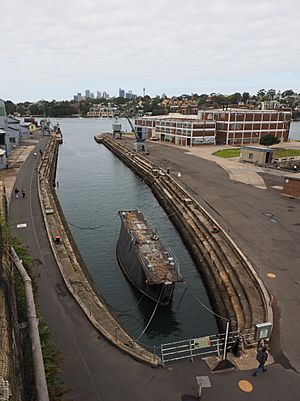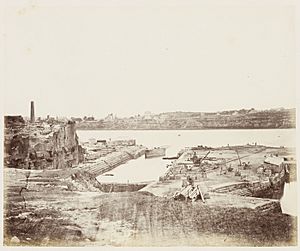Fitzroy Dock facts for kids
Quick facts for kids Fitzroy Dock |
|
|---|---|

Fitzroy Graving Dock
|
|
| Location | Cockatoo Island, Sydney Harbour, New South Wales, Australia |
| Official name: Fitzroy Dock | |
| Type | Listed place (Historic) |
| Designated | 22 June 2004 |
| Reference no. | 105261 |
| Lua error in Module:Location_map at line 420: attempt to index field 'wikibase' (a nil value). | |
Fitzroy Dock is a very old and important dockyard located on Cockatoo Island in Sydney Harbour, New South Wales, Australia. A dockyard is a place where ships are built and repaired. This historic site was added to the Australian Commonwealth Heritage List on 22 June 2004, meaning it is protected for its special value.
Contents
History of Fitzroy Dock
Cockatoo Island first became a prison in 1839. This happened after the Governor of New South Wales, George Gipps, suggested sending convicts there. The convicts helped build many things on the island, including the Fitzroy Dock.
Building the Dockyard
Fitzroy Dock was finished in 1857. It was built to help repair ships for the Royal Navy. Cockatoo Island soon became the main government dockyard in Australia.
In 1869, the prisoners left the island. The prison buildings were then used as a school for girls and a reformatory. The dockyard area was separated from these buildings by a fence. After the girls left in 1888, prisoners returned until about 1909.
Meanwhile, the dockyard grew bigger. Another large dock, the Sutherland Dock, was built in 1890. The island became known as the state dockyard.
Role in Australian History
In 1913, after Australia became a federation, the Australian Government took over Cockatoo Island. It was renamed the Commonwealth Dockyard. The island played a very important role in building and fixing ships for the Royal Australian Navy. It was especially busy during World War I. The old prison buildings were used as offices.
From 1933, a company leased the dockyard. The island continued to be very important during World War II. After the war, the dockyard kept working. New facilities were added for submarines. The dockyard finally closed in 1992. Today, the island is managed by the Sydney Harbour Federation Trust.
How Fitzroy Dock Was Built
Fitzroy Dock was built to repair Royal Navy ships in eastern Australia. Cockatoo Island was chosen because it had good stone for building. Also, there were many convicts available to do the hard work.
The idea for the dock was proposed in 1846. Construction began in 1851. It was the first large dry dock started in the Southern Hemisphere. A dry dock, also called a graving dock, is a basin that can be drained of water. This allows workers to access the bottom of a ship for repairs.
Another dock, Mort's Dock, was built faster using free workers. It took only one year to build. Fitzroy Dock, built by convicts, took six years. When it was finished in 1857, Fitzroy Dock was the largest dry dock in the Southern Hemisphere. It was also one of the biggest in the world at that time. It was the largest engineering project ever completed in Australia. Today, it is the oldest dry dock still existing in Australia.
Captain Gother Kerr Mann designed and oversaw the building of the dock. He was the chief engineer on Cockatoo Island. The dock was named after Governor Sir Charles Augustus FitzRoy. He laid a special stone in 1853.
Steam-powered pumps for the dock were bought from London. Henry Broderick brought them to Australia. He became the first dock master. Building the dock involved blasting a large cliff. This was the first time electricity was used to set off gunpowder in Australia.
Dock Operations and Changes
Workers, at first convicts, would shore up, scrape, clean, and paint ships in the dock. Until Sutherland Dock opened in 1890, all Royal Navy ships were repaired at Fitzroy.
Ships became longer over time, so Fitzroy Dock was made longer twice. It grew from about 96 metres to its current length of about 145 metres. This work was done by free workers. When Sutherland Dock opened, its new pump house took over pumping water for Fitzroy Dock too.
During the 1900s, Fitzroy Dock continued to serve smaller naval ships. This included destroyers of the Royal Australian Navy. The dock was very important during both the First and Second World Wars.
Description
Fitzroy Dock is located on the south-eastern side of Cockatoo Island in Sydney Harbour. It is a dry dock about 145 metres long. Its sides have steps made of sandstone blocks. These steps help to support ships while they are being repaired.
The original bollards, which are strong posts for tying up ships, are still there. They were made from old cannons. The floating gate, called a caisson, that closes off the dry dock might be from the early 1900s. It is made of metal plates and has a rubber seal.
Fitzroy Dock is one of the biggest public works built by convicts in Sydney. It is a very important part of Cockatoo Island's look. It strongly shows the island's history with ships and convicts. This gives it great aesthetic (beauty) value.
Condition
In 1997, a report noted that the caisson (the dock gate) needed repairs. As of May 2001, the dry dock was filled with water.
Heritage Listing
Fitzroy Dock was added to the Australian Commonwealth Heritage List on 22 June 2004. It met several important criteria:
- Criterion A: Processes
Fitzroy Dock is the oldest dry dock still existing in Australia. It connects directly to the convict era in Sydney. It also shows Australia's maritime history and its naval connections with other countries. It was very important during World War I and World War II. It has great historical importance.
- Criterion B: Rarity
This dock is one of the largest public works built by convicts that still exists in Sydney.
- Criterion D: Characteristic values
Fitzroy Dock is a great example of a 19th-century harbour facility of its kind.
- Criterion E: Aesthetic characteristics
Fitzroy Dock is a major part of Cockatoo Island's landscape. It helps create the island's special atmosphere related to ships and convicts. This gives it significant aesthetic value.
- Criterion F: Technical achievement
The dock was the first dry dock started in Australia. It was the largest engineering project completed in Australia at that time. It was also very large compared to other docks worldwide. This shows its great technological importance and good design.


